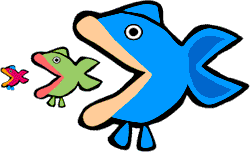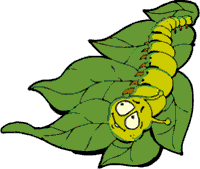Hands-on Activities: Food Chain
Grade Level K-4
Essential Question 1 What is a food chain?
Objective 1 Students will relate various animals to each other in the form of a food chain.

Materials 1 poster board, books or magazines about plants and animals, pictures of plants and animals, glue or tape, and thread or string (optional)
Approach 1 Display a large piece of poster board in the classroom, then present the following: Most living things are predators. That means they eat other living things. The living things predators eat are called their prey.
Each week ask the students to choose one living thing to study. Instruct them to place a picture of that plant or animal on the poster board. Ask them to find out what it eats as well as what eats it. Do not remove the pictures from the poster board. During the year (or as long as you wish to continue this activity), ask the students to discuss the predator-prey relationships among the living things they have studied. How is each predator-prey relationship related to others? How do these relationships form a chain that links many living things together?
Reflection 1 Students can apply their knowledge of food chains to create a food web. They can display the predator-prey relationships among the living things pictured on the poster board by connecting the appropriate pictures with thread or string. Ask them to imagine that one of the animals is extinct. Then ask them to explain how that fact would affect all of the other animals. They can trace the string to find all of the animals affected by the death of one animal.

Essential Question 2 Can animals protect themselves from being caught by predators?
Objective 2 Students will learn the concept of predator-prey relationships, including ways organisms camouflage or hide themselves to avoid becoming prey.
Materials 30 short pieces of red yarn (or 30 red toothpicks); 30 short pieces of green yarn (or 30 green toothpicks); large, green area (carpet, blanket, grass, etc.); timer or stopwatch; paper; pencil; graph paper (optional); and crayons (optional)
Approach 2 Cut 30 short pieces of red yarn and 30 short pieces of green yarn. (Note: Instead of yarn, you can use 60 toothpicks—dye 30 of them red and 30 green.) Spread all 60 pieces of yarn (or toothpicks) over a large, green area. Present the following to your students: Pretend the pieces of yarn (or toothpicks) are caterpillars crawling on the grass. Pretend you are a bird. You are a predator. The caterpillars are your prey. You need to catch the caterpillars to survive. Each of you has one minute to hunt for caterpillars. Cut 30 short pieces of red yarn and 30 short pieces of green yarn. (Note: Instead of yarn, you can use 60 toothpicks—dye 30 of them red and 30 green.) Spread all 60 pieces of yarn (or toothpicks) over a large, green area. Present the following to your students: Pretend the pieces of yarn (or toothpicks) are caterpillars crawling on the grass. Pretend you are a bird. You are a predator. The caterpillars are your prey. You need to catch the caterpillars to survive. Each of you has one minute to hunt for caterpillars.
Allow each student, one at a time, one minute to collect as many pieces of yarn (or toothpicks) as he or she can. Count the number of red caterpillars collected. Count the number of green caterpillars collected. Record this information. Return all of the caterpillars to the green area so the next student can take a turn catching caterpillars.
How many red caterpillars did all of the "birds" catch? How many green caterpillars? Older students may graph the results. Did the birds catch equal numbers of red and green caterpillars? Did the birds catch more caterpillars of one color than the other? Why? Most likely, they caught more red caterpillars than green ones. If this is the case, ask the students if they can explain why. They will probably say the red ones were easier to see in the grass than the green ones. Explain to them that being green is an evolutionary trait that some caterpillars have developed. This means that over very long periods of time, green caterpillars have survived attacks from predators. The surviving green caterpillars have gone on to produce more green caterpillars.
Reflection 2 What are some other animals that use their coloring to hide from predators? Are there other ways that animals protect themselves? Students can write a report on or draw a picture of an animal protecting itself from a predator. Illustration © 2003 www.clipart.com. |











